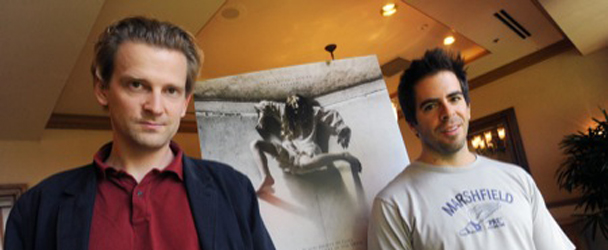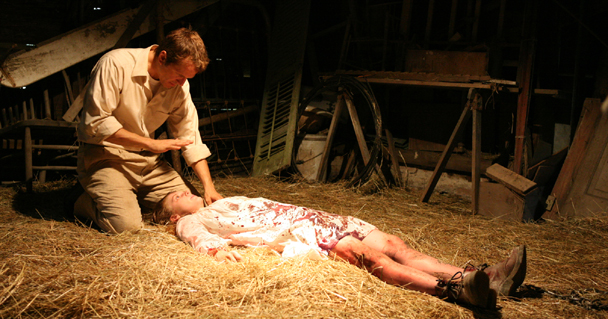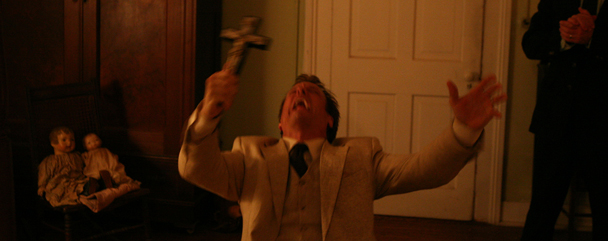Eli Roth and Daniel Stamm
The pair talk mockumentaries, the religious backlash and The Last Exorcism.

The Last Exorcism follows Reverend Cotton Marcus as he makes a documentary designed to reveal the fraudulent nature of exorcisms. On a Lousiana farm, in the Deep South of America, Reverend Cotton meets a sixteen year old who defies his conclusions. Pure Movies catches up with Eli Roth and Daniel Stamm to talk mockumentaries, the religious backlash and The Last Exorcism.
Download the Pure Movies podcast featuring an extended interview for free on iTunes here.
Listen to the interview now: [audio:episode3.mp3]
The Last Exorcism has done exceptionally well in the US in its first weekend. Why?
Eli Roth: (Laughs) Well, if we knew that then everyone would be replicating it. But, for years we felt that the audience appetite for a film in this subject matter was huge. There hadn’t been an original exorcism/possession story told in a long time. The script was so good, so smart that, at the early screenings, people were coming out saying it was one of the most original, scariest, smartest, thought-provoking films they’d ever seen. It was much different from what people thought it was going to be. They expected possession with yellow eyes and they got this great psychological thriller about a girl who might be crazy or might be possessed. People were coming out of it saying they’d never seen acting like that in a horror film. They flocked to it.
Were you convinced early on that the film would be as successful as it has been?
Eli Roth: Well, you don’t make movies for failure. You build for success always. Every movie you make you feel in your heart of hearts that it could be as big as Avatar. Even though you know that there’s only one Avatar. You don’t make a movie thinking that it’s for a small audience. You make it believing truly that it’s going to be a hit. And that belief has to carry out to everyone who sees the film and everyone who buys the film. But I’ve seen it, it’s not just blind belief. I’ve done it with Hostel. That movie cost $3.8m and it opened at $19m. So that audience is there. If you give them something they will come out and support it. And they trust me now. So we did this movie for under $2m and it makes over $20m on the opening weekend. It’s really incredible and it’s just sent shockwaves through Hollywood.
With the success of movies like Blair Witch, Cloverfield and Paranormal Activity, do you think that the mockumentary Handy Cam genre will be long lasting?
Daniel Stamm: I hope it will, because it’s such a rich style. I think it will grow past the gimmicky reputation that it has at the moment. Because, if you look at these movies, they’re very different movies. Godzilla… er… what’s it called?
ER: Cloverfield.
DS: Cloverfield was a kind of Godzilla movie. Then you have Paranormal Activity which was a haunted house movie. They are very different movies and, other than that they were filmed with a handheld camera and have a first person narrative, they are completely different. And The Last Exorcism is all about acting and storytelling, whereas Paranormal Activity is a brilliant exercise in rhythm and expectation. So it’s such a rich, wide field that I think there is a lot more to tell in that style.
Is the Handy Cam method of filming as haphazard and organic as it looks?
DS: Very much. Because you don’t get held back by all the technical aspects. You don’t wait for lighting; you don’t light a close-up for four hours; you don’t build a crane or dollies. Instead, it’s all focused on the actors. And you shoot on video so you can just keep the camera rolling. You can keep the camera rolling for four hours a day and make sure you catch every brilliant moment. There isn’t one brilliant moment that you don’t catch. And that does something to the actors. You don’t have to “slate”, which means you don’t signal to the actors to create artifice, to start pretending. But they just have this free-flowing thing where they forget to be on, which is exactly what you want. And you can create an atmosphere where it’s OK to experiment and it’s OK to do thirty takes of something. Because it’s not about nailing it. It’s about discovering things and creating fresh moments.
So you must have a lot of footage which you whittle down into the final movie?
DS: Sure, hundreds of hours.

Why, Eli, do your movies feature no big name actors? Is it to save on the wage bill?
ER: Well, when I was growing up, I didn’t know who was in my favourite horror movies. When I watched those movies, for the rest of my life they became that person from that movie. They were that character. So, unless you’re talking about a movie like The Shining, for us all to properly buy into the conceit that this is a documentary, if there was a known actor you’d be thinking about them in ten other roles. Thinking, ‘OK, I know it’s not that guy.’ So the trick with this movie was finding Patrick Fabian [the lead]. How do you find an actor that age, who’s that good, who hasn’t already been discovered? And Daniel did it. It was just finding the right person for the right role. I saw Tarantino do it with Christoph Waltz in Inglorious Basterds. The guy had been working in television in Germany and Austria for thirty years. And he just got the right part, and was clearly ready. That’s like what Daniel did in finding Patrick out of hundreds of actors. But I think having smaller names does help you keep it low budget. But that only works in a certain type of story. It’s not a formula. You can’t say, ‘Yes, you need no stars in Horror Movies, just great actors.’ I think it helps though.
DS: The actors don’t have to work against their own persona; to get over their mannerisms. It also avoids something which is poison for any good actor: vanity. You want them to get lost in the character. Like Ashley Bell [who plays Nel, the possessed girl] when she’s covered in sweat, with snot coming out of her nose, she loves that because that is her character. It’s not her that she sees on screen. She’s not thinking, ‘Oh, am I coming across as pretty.’ But she loves disappearing in that character. And I think you can achieve that much better if you don’t work with big name actors.
But isn’t it tempting to work again with actors that you can get so much out of?
ER: It depends what story you’re telling. I’d be honoured to work with either of those two again.
DS: I would absolutely. But then again there is something very exciting about working with new actors again. Because otherwise you have the same effect as if you cast star name actors. I mean these two actors to me are so much Cotton and Nel that I would almost have problems working with them right now and creating a completely different character. Even though I know their abilities and I know that they could pull off almost anything.
Do actors get emotionally messed up working on movies like this?
ER: Actors are emotionally messed up. That’s why they’re actors.
DS: And you want to get them emotionally messed up. I’m getting stuff from them after take thirty when they’re upset, they want to go home, they’re tired. You get an intensity which you don’t get normally when everyone is fresh in the morning. So you want to get them messed up. And I think they want themselves to get messed up. That’s kind of the task.
ER: They want to be pushed. It’s like therapy for them. They love it. They’re very complicated people and they have a lot of stuff inside. And if they lose themselves in a character they then let out a lot of emotions that they keep bottled up which they have no other way of expressing.
So, no lasting damage?
ER: A movie doesn’t cause damage. It’s family situations and growing up that causes damage. We’re just dealing with the residual of that damage. Not to say that all actors are damaged, but something’s going on. There’s a reason they’re actors.
You’re treading some hotly contested ground with the religion versus science dimension of the movie. Have you had any backlash from religious groups?
ER: Not at all. One of the things that religious groups have loved about the movie is how fairly their side is presented. Not just fairly, but intelligently. That the movie doesn’t take a position. It’s [Reverend] Cotton who is saying ‘Get her a psychiatrist’ but [the girl’s father] Lewis, a man of devout faith, is quoting The Bible and saying things that really make sense. He’s a loving father and a good person and a good churchgoer. So they feel that their position is very fairly represented. And ultimately the film has an underlying message that you should believe, and that you shouldn’t mess with forces bigger than you. But also the film itself is a documentary that comes from a place of confession. Cotton is starting out saying this is wrong what I have done [performing phoney exorcisms], and he’s doing the documentary to prevent it from happening. As he says, ‘If I can prevent one child from being suffocated with a plastic bag around his head [during an exorcism], that sounds like God’s work to me.’ I thought that was what was so smart about Daniel’s whole approach. [Speaking to Daniel] I mean you saw in Texas, the religious groups loved it?
DS: Yeah. I wouldn’t understand if it didn’t appeal to them. We wanted to bring these two forces together and let them clash. But make a very fair case for both of them and see how it plays out. So I wouldn’t understand if they did have a problem with it. And if they did then I think we’re seeing a tragedy because these two parts aren’t able to communicate. They’re not able to actually find a bridge and work together. Neither of them are willing to compromise. And anyway that’s why they’re not able to save the girl in the end. But that is as much a problem with the science as it is with the faith.

The scene of the first exorcism is cut with clips of Reverend Cotton showing off his smoke-emitting crucifix, pre-recorded “demon” noises, and other fake exorcism gimmicks. Were you worried that the humour might detract from the tension?
DS: I wasn’t really because we were only using it in the first half. Once it gets dark we fade out the humour. I find humour to be a really strong tool for making characters likeable. And we need that because Cotton has a very questionable past. And how do you get the audience on board with the character from very early on? You do that by making the time that they spend with the character enjoyable. You do that through humour. More than anything it’s a trick to get the audience on board, and bind them to him.
ER: In Hostel and in Cabin Fever I spent forty five or fifty minutes just setting up the characters. And what I’ve noticed is that audiences at first fight it a little, but then, if you give them a reason to be engaged, they actually get more tense because they think, ‘gosh he hasn’t scared me yet what’s coming next? They must be so confident about what’s coming at the back end of this film that I’m now even more dreading what’s coming.’ Really build the sense of dread. What Daniel did so beautifully was this one hundred and eighty degree arc that everyone goes through. Where, at the beginning, Cotton’s in control. It’s light, it’s sunny, it’s day time. And even in that first exorcism he’s playing on clichés of The Exorcist. And we’re watching Lewis crying and saying, ‘Please, please, get the demon out of her!’ But at the end of the movie, Cotton is drawn into the ceremony, which has really nothing to do with Nel and everything to do with Cotton. All these theatrics, the same theatrics that he was doing on Lewis, are now being done on him, with the devil worshipping. But because he doesn’t believe in God he just thinks these people are crazy. He’s like a moth drawn into that fire. And he just goes closer and closer and closer. And it’s so theatrical he can’t stop filming it. He has to know what they’re doing, because he doesn’t believe that Satan is real. And, of course, once the demon reveals itself then he finds God but by then it’s too late. Because that’s not true faith, that’s just a reaction. So I thought that to start in this place of Church and God and happiness and end up with him literally entering into a horrible hell was a brilliant turn. So, therefore, all the set-up at the beginning and all the humour and everything actually does pay off in the end. At the beginning, he’s doing his banana bread speech [during a sermon], but by the end of the film the devil worshippers are chanting the phrase ‘banana bread’ backwards. It’s a weird mirror image. So at the end, you don’t realise that you’ve been drawn into a mirror image of everything at the beginning.










COMMENTS